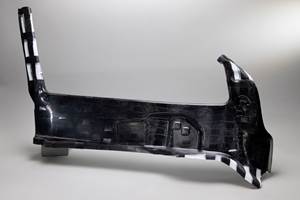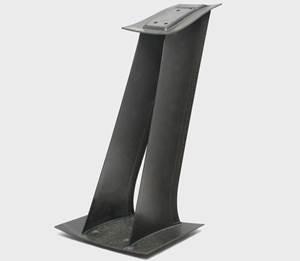Where are those promised composites technologies now?
Promising technologies of yesteryear: Where are they now? What can be learned from unfulfilled promise?
Share
Routinely, a television show or magazine will highlight what happened to celebrities from the past — musicians, child television stars, one-hit wonders, etc. These segments, frequently titled, “Where Are They Now?,” often find these oldtimers living well, but away from the limelight, without the trappings of fame or fan clubs. Doubtless, a few that seemed destined for long-term success found their careers diverted or simply interrupted.
We have some analogues in the composites world. A technology comes along that seems to set the world on fire, or shows incredible promise, only to stagnate or ebb, never achieving the “hockey stick” shaped forecasts provided by early entrants and the investment community. Although that list is long, I looked back over the past 10-15 years and found a few worth mentioning.
The first is the proton exchange membrane (PEM) fuel cell, which generates power from the simple mating of hydrogen and oxygen, producing water as a byproduct.
PEMs were heavily promoted as a solution to high gasoline prices in the late 1990s. Shares of the leading players, Ballard Power Systems and Plug Power, soared on the promise of millions of cars and homes running on cheap, clean hydrogen power. For composites, the opportunity was certainly attractive — PEM cells made use of molded, conductive bi-polar plates, carbon fiber membranes and high-pressure, lightweight compressed hydrogen tanks wound with high-strength carbon fiber. Honda, Mercedes, GM and other OEMs fielded test fleets. Suppliers developed materials to serve what was surely enormous growth potential. Ultimately, excitement waned, due to poor cold weather performance, cost issues — especially with pollutant-sensitive, expensive platinum catalysts — and the lack of a refueling infrastructure for gaseous hydrogen.
So where are they now? Although some hurdles have been cleared, others remain. Ballard and Plug Power are still alive, but focused on fleet vehicles and clean power for industrial and IT firms, having scaled down growth expectations. Toyota, BMW and other OEMs still dabble with PEMs, but only in niche markets.
Around 2000, a second example was TWINTEX, a Saint-Gobain Vetrotex America commingled tow, produced by combining polypropylene (or PET) fibers in line with the drawing of the glass fibers. is eliminated the need for the secondary process usually associated with commingling, therefore offering a lower price point. Woven into wide, long rolls, TWINTEX fabrics and tows saw extensive end-use product development in automotive components, impact-resistant watercraft, pallets and shipping containers, among others. The performance/price ratio boded well for exceptional market growth. But despite attractive material pricing, processing of TWINTEX was not always easy nor rapid.
Where is TWINTEX now? In 2007, Saint-Gobain Vetrotex America reinforcements business was acquired by Owens Corning Composite Solutions Business, and the technology portfolio was subsequently sold to Fiber Glass Industries in 2012. After FGI’s operations ceased in 2014, production of TWINTEX also ceased and FGI’s assets were sold to SAERTEX USA LLC. Commingled fibers produced by conventional means are today supplied by Concordia Fibers, Innegra Technologies, Coats Group, and Schappe Techniques, albeit without the large-volume expectations of TWINTEX.
I might get some pushback on this one, but a third technology with unrealized potential are carbon-based nanomaterials. In the mid-2000s, carbon nanotubes were extensively promoted as the next transformational material for composites. The space attracted researchers, industrial entrants (existing and startup) and wide media coverage. A broad range of materials, including vapor-grown nanofibers, Buckminsterfullerenes (“buckyballs”), single-walled nanotubes (SWNT) and multi-walled nanotubes (MWNT) were targeted as additives to matrix resins to enhance impact, thermal, electrical and other performance characteristics. And SWNTs and MWNTs could be added to the surface of conventional carbon fibers to leverage fiber-to-resin adhesion, enhancing compression or shear strength. Standing in the way of that explosion of growth were issues with poor dispersion in the matrix, commercial scalability and cost.
So where is carbon nanotechnology now? Small quantities of carbon nanotubes/nanofibers are produced and sold into niche applications, largely for sporting goods. But clumping, difficulty with volume production and high prices have quelled the fervor in most markets. Recent efforts are focused on graphene, in platelet and sheet form, with electronics the most promising future market.
Innovation is the lifeblood of any industry, and composites are no exception. These examples and others like them, though legitimately promising, were hurt by unreasonably elevated expectations. It’s also possible that inventions like fuel cells arrive before the market is ready to adopt them, but might ultimately succeed. That has me wondering what are today’s “next big things” that we will be looking back on and wondering “where are they now?” in 2030?
Institute for Advanced Composites Manufacturing Innovation (IACMI)
Related Content
PEEK vs. PEKK vs. PAEK and continuous compression molding
Suppliers of thermoplastics and carbon fiber chime in regarding PEEK vs. PEKK, and now PAEK, as well as in-situ consolidation — the supply chain for thermoplastic tape composites continues to evolve.
Read MoreHighly tunable, woven lattice reinforcements target automotive structures
CAMX 2023: Startup Weav3D will be demonstrating its two collaborative automotive demonstrator parts and present two conference papers.
Read MoreComposite resins price change report
CW’s running summary of resin price change announcements from major material suppliers that serve the composites manufacturing industry.
Read More3D weaving capabilities achieve complex shapes, reduce weight and cost
JEC World 2024: Bally Ribbon Mills is displaying film-infused 3D woven joints, woven thermal protection systems (TPS) and woven composite 3D structures.
Read MoreRead Next
Plant tour: Daher Shap’in TechCenter and composites production plant, Saint-Aignan-de-Grandlieu, France
Co-located R&D and production advance OOA thermosets, thermoplastics, welding, recycling and digital technologies for faster processing and certification of lighter, more sustainable composites.
Read MoreVIDEO: High-volume processing for fiberglass components
Cannon Ergos, a company specializing in high-ton presses and equipment for composites fabrication and plastics processing, displayed automotive and industrial components at CAMX 2024.
Read MoreAll-recycled, needle-punched nonwoven CFRP slashes carbon footprint of Formula 2 seat
Dallara and Tenowo collaborate to produce a race-ready Formula 2 seat using recycled carbon fiber, reducing CO2 emissions by 97.5% compared to virgin materials.
Read More





















